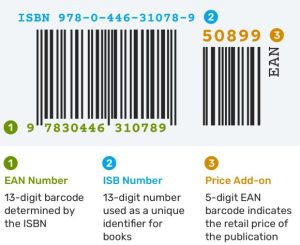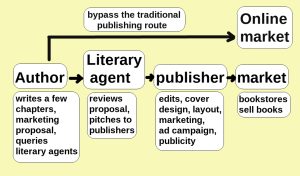The journey of book publishing from ancient papyrus scrolls to the digital era marks a profound transformation in how literature is created, distributed, and consumed. The evolution of Book Publishing has been transformed throughout centuries and has adapted and kept pace with the changing times.
Imagine the tactile sensation of vellum beneath your fingers: the calfskin pages are both smooth and luxuriously thick, with the text printed in sharp, black ink. Each chapter begins with a vibrant red letter, drawing the eye. An early reader, moved by the text, sketched a hand with an extended finger pointing towards memorable passages, guiding future readers through the wisdom contained within.
In the year 44 BC, Cicero, one of the most eloquent orators of the Roman Republic, penned “De Officiis” (“On Duties”) for his son Marcus. This treatise on ethics, virtue, and practical wisdom not only absorbed insights from Greek philosophers available in Cicero’s vast library—many of which are now lost—but also offered original thought that has endured through millennia. Cicero’s work remained influential through the rise and fall of the Roman Empire, inspired Renaissance scholars like Erasmus, and centuries later, captivated Voltaire, who proclaimed it unsurpassable in wisdom.
 The medium of Cicero’s words has undergone countless transformations. Originally dictated to Tiro, his freed slave, and recorded on a papyrus scroll, “De Officiis” transitioned to bound codices a few centuries later, eventually being painstakingly reproduced by monks, and, by the 15th century, printed on one of the earliest presses in Mainz, Germany, by Johann Fust, a collaborator of Johannes Gutenberg. The edition held today, dating back to 1466, represents a significant moment in the history of the book, surviving over five centuries, now residing in the Huntington Library in San Marino, California.
The medium of Cicero’s words has undergone countless transformations. Originally dictated to Tiro, his freed slave, and recorded on a papyrus scroll, “De Officiis” transitioned to bound codices a few centuries later, eventually being painstakingly reproduced by monks, and, by the 15th century, printed on one of the earliest presses in Mainz, Germany, by Johann Fust, a collaborator of Johannes Gutenberg. The edition held today, dating back to 1466, represents a significant moment in the history of the book, surviving over five centuries, now residing in the Huntington Library in San Marino, California.
Despite its physical confinement, “De Officiis” has never been more accessible, transcending its traditional bindings to be available in various formats—hardbacks, paperbacks, and notably, digital versions. This transition to digital media has sparked concern among some about the future of traditional bookshops, the surge of new authors, and the dominance of online giants like Amazon. Yet, the evolution of book technology—from the tangible to the digital—is not just a narrative of loss but of adaptation and potential.
Books, after all, are a form of technology themselves, one that has significantly contributed to the progress of human thought. The printing revolution initiated by Gutenberg and others democratized knowledge, fueling movements like the Reformation, the Enlightenment, and the scientific revolution. The power of the printed word to educate, inspire, and provoke change is unparalleled.
Digital books, while continuing this legacy, introduce new dimensions to the reading experience. E-books not only facilitate a seamless exchange of ideas between readers across the globe but also offer insights into reading patterns, enhancing our understanding of literature’s impact. The intimacy of reading is preserved, even as digital platforms foster a new communal engagement with texts.
The future of the book, contrary to the fears of some, promises a blend of tradition and innovation. As the narrative of book publishing unfolds from papyrus scrolls to digital screens, it’s clear that the essence of literature—its ability to convey complex ideas, stir emotions, and connect individuals across time and space—remains unchanged, if not strengthened, by technological advancements.
How has the journey of Cicero’s “De Officiis” from ancient manuscript to digital text reflected the broader evolution and enduring significance of books through history and into the digital age?
- Historical Significance of “De Officiis”: Cicero’s “De Officiis” is highlighted as a timeless piece of literature, having influenced countless generations from the Roman Empire through the Renaissance to the Enlightenment, demonstrating the enduring power of written wisdom across millennia.
- Evolution of Book Publishing: The transition of “De Officiis” from papyrus scroll to digital formats exemplifies the broader transformation in book publishing. This evolution showcases the shift from manual reproduction methods to the digital age, highlighting the adaptability and resilience of the book as a medium for disseminating knowledge.
- Digital Era and the Future of Books: The adaptation of books into digital formats opens new avenues for reader engagement and knowledge sharing, enhancing the traditional reading experience through technology. Despite concerns about the digital transition, the future of books is portrayed as promising, blending historical tradition with technological innovation to extend the reach and impact of literature.
Chapter II: The Unfolding Narrative of Books in the Digital Realm
The narrative of books and their place in our culture has been marked by a constant interplay between innovation and tradition, sparking debates on the future of reading in the digital age. As digital technologies have ascended, spearheaded by behemoths like Amazon with its unprecedented online bookstore, concerns over the demise of traditional reading formats have surged. The past decade has been rife with predictions forecasting the end of printed books, the decline of publishing houses, the challenges facing authors, and the potential obsolescence of brick-and-mortar bookstores. Yet, despite these ominous forecasts, the predicted cataclysms have largely not come to pass, with the notable exception of physical bookstores, which have indeed felt the impact of digital transformation.
 Historically, books were considered luxuries, their accessibility limited to the affluent few. However, the 20th century brought about a democratization of books, making them affordable and available to the wider public. The 21st century has taken this accessibility further, with digital technologies and global markets enhancing it even more. The issuance of around 1.4 million International Standard Book Numbers (ISBNs) in 2013, a stark increase from the 8,100 in 1960, underscores this expansion. Moreover, this figure doesn’t even account for the burgeoning sector of self-published e-books, which often bypass the traditional ISBN system. This self-publishing boom has welcomed a diversity of genres and forms, including niche areas like Amish fiction, and revived shorter literary formats such as novellas and short stories, which had previously been constrained by the economics of print publishing.
Historically, books were considered luxuries, their accessibility limited to the affluent few. However, the 20th century brought about a democratization of books, making them affordable and available to the wider public. The 21st century has taken this accessibility further, with digital technologies and global markets enhancing it even more. The issuance of around 1.4 million International Standard Book Numbers (ISBNs) in 2013, a stark increase from the 8,100 in 1960, underscores this expansion. Moreover, this figure doesn’t even account for the burgeoning sector of self-published e-books, which often bypass the traditional ISBN system. This self-publishing boom has welcomed a diversity of genres and forms, including niche areas like Amish fiction, and revived shorter literary formats such as novellas and short stories, which had previously been constrained by the economics of print publishing.
Contrary to the grim prophecies of the book’s extinction, the reality of the digital age has seen a softening of these predictions. Nicholas Carr, author of “The Shallows,” which posited that the internet might diminish our capacity for concentration and contemplation, acknowledges a surprising resilience in the attachment to physical books among readers. This attachment underscores a craving for immersive experiences, undiluted by the distractions of digital media. While reading for pleasure has seen a slight decline, it hasn’t plummeted as many feared. The continued popularity of lengthy novels, such as Donna Tartt’s “The Goldfinch,” indicates that the appetite for substantial, challenging works remains robust.
The anticipation of the e-book overtaking the physical book has not materialized as expected. Early predictions underestimated the enduring appeal of the print book, a “competitive technology” celebrated for its simplicity, portability, and user-friendliness. Attempts by technology companies to revolutionize the e-book format with features like embedded multimedia have largely failed to capture readers’ interest. The market for dedicated e-readers, such as Amazon’s Kindle, is declining, suggesting that these devices may be remembered as a brief phase in the history of media consumption.
However, the versatility of multi-purpose tablets has ensured that electronic books remain a convenient option for many, especially avid readers of genre fiction. Yet, various segments of the book market continue to show a strong preference for print, from the tactile pleasure of physical books as gifts to the use of print books as a screen-free alternative for children, promoting a new generation’s engagement with printed media.
The resilience of the publishing industry, too, has been notable. Contrary to the disruptions experienced by the music and newspaper industries, book publishing has maintained its volume of sales, with publishers continuing to play a pivotal role in the literary ecosystem. The incorporation of digital technologies like print-on-demand has mitigated risks associated with overproduction and returns, demonstrating an effective fusion of digital efficiency with the tangible appeal of printed books.
Also read: 20 Awesome Books Under 200 pages
The shift towards digital has also prompted a reevaluation of where and how books are sold, with a significant impact on physical bookstores. The decline of these cultural institutions has not only affected publishers and booksellers but has also transformed the discoverability of books, favoring bestsellers and challenging the visibility of midlist titles. In response, bookstores have evolved, curating experiences that celebrate the act of reading and the physical book itself.
In confronting the digital challenge, the book industry has navigated a path marked by adaptation and resilience. While the dominance of online retailers like Amazon has introduced new pressures, the book world’s response has been multifaceted, balancing innovation with the preservation of the book’s essential qualities. As the narrative of books in the digital age continues to unfold, it is clear that the essence of reading and the cultural significance of books remain undiminished, testament to their ability to adapt and thrive amidst change.
How have digital transformations in publishing affected the perceived decline of traditional books and contributed to the expansion and diversification of literature in the modern era?
- The Predicted Decline of Books Has Been Overstated: Despite fears of digital technologies rendering traditional books obsolete, the core elements of the book industry—publishing, authorship, and the printed book itself—have shown remarkable resilience.
- Increased Accessibility and Diversity: The digital age has expanded access to books, both through the proliferation of ISBNs and the rise of self-publishing, catering to a wider range of interests and preferences and revitalizing shorter literary forms.
- The Enduring Appeal of the Physical Book: The tactile and immersive qualities of printed books continue to hold significant value for readers, despite the convenience of digital alternatives, underscoring the enduring relevance of physical books in our digital world.
Chapter III: Bridging Worlds: Modern Authors and Their Diverse Readerships
Gone are the days when authors navigated the laborious path of self-publishing with its logistical nightmares, reminiscent of an era when writers like one in Paris had to guide readers to his dwelling just to sell a book. The rise of self-publishing in recent years has dismantled the stigma once associated with authors taking the helm of publishing their work. This shift is largely attributed to the internet’s ability to simplify the distribution of both e-books and print books, making success stories possible on an unprecedented scale.
At a notable London Book Fair, a group of eight authors showcased their collective triumph, boasting sales of 16 million books and prominent placements on the New York Times bestseller list, achieved independently of traditional publishing houses. Their success, often met with skepticism, underscores a significant change in the publishing landscape. Romance writer Bella Andre and her peer, Barbara Freethy, exemplify this shift, with Freethy selling over 4.8 million books by navigating the digital marketplace.
 Publishing a book today can be as cost-effective as the author chooses, with expenses for professional editing, cover design, and marketing services potentially totaling less than $2,000. Platforms like Amazon offer authors a lucrative deal, paying up to 70% of net sales for self-published e-books—a stark contrast to the traditional publishing model.
Publishing a book today can be as cost-effective as the author chooses, with expenses for professional editing, cover design, and marketing services potentially totaling less than $2,000. Platforms like Amazon offer authors a lucrative deal, paying up to 70% of net sales for self-published e-books—a stark contrast to the traditional publishing model.
The surge in self-published titles is notable, with Amazon’s self-published book sales reaching an estimated $450 million. In 2013, self-published works constituted one-fifth of e-books purchased in Britain, showcasing the format’s growing acceptance among readers.
The story of “Wool” by Hugh Howey epitomizes the potential of self-publishing, evolving from an online short story to a bestselling novel and a potential film adaptation. Similarly, E.L. James’s “Fifty Shades of Grey” transitioned from online fiction to a publishing phenomenon, with its discreet e-book format initially fueling its success.
Despite the allure of self-publishing, the traditional publishing path remains attractive for its access to the print market and editorial support. However, the rise of self-publishing has compelled publishers to adapt, reevaluating pricing strategies and scouting talent on platforms like Wattpad, where community feedback shapes emerging voices.
The financial landscape for self-published authors varies, with many relying on Amazon’s recommendation algorithms and promotional sites to connect with readers. Yet, the perceived benefits of traditional publishing are being reexamined. Authors like Barry Eisler and Susan Orlean are contemplating the value of publishers’ services, suggesting a future where these services might be unbundled or reimagined to better serve authors’ needs.
Publishers acknowledge the need for adaptation, recognizing that their relevance hinges on connecting authors with readers more effectively than any alternative. This evolving dynamic underscores a return to the social and personal roots of book creation, where the relationship between author and reader is paramount.
The digital age has revived the ancient tradition of direct engagement between authors and their audiences, reminiscent of Cicero’s era when writers would read their work aloud to gather feedback. Today, social media and literary festivals offer modern platforms for this interaction, blending the personal connection with the wide reach of digital publishing. This blend of old and new reflects the enduring essence of literature as both a personal endeavor and a shared experience, navigating through the challenges and opportunities presented by the digital revolution in publishing.
How has the rise of self-publishing and digital platforms transformed the relationship between authors, publishers, and readers in the contemporary literary landscape?
- Revolution of Self-Publishing: The digital era has transformed self-publishing from a logistical and stigmatized endeavor into a viable and often lucrative path for authors, enabling them to reach wide audiences without the traditional gatekeepers of the publishing industry. Success stories of self-published authors, such as Bella Andre and Hugh Howey, highlight the potential for significant sales and recognition outside conventional publishing frameworks.
- Cost-Effective and Accessible Publishing Models: With the advent of online platforms like Amazon, authors can now publish and distribute their work at minimal costs, retaining a higher percentage of sales revenue compared to traditional publishing deals. This democratization of publishing has led to a surge in self-published titles, allowing for a greater diversity of stories and voices to reach the market.
- Impact on Traditional Publishing and Author Engagement: The rise of self-publishing is prompting traditional publishers to adapt by reevaluating pricing strategies and scouting for new talent on digital platforms. Additionally, the direct connection between authors and readers, facilitated by social media and other online forums, echoes the personal and social aspects of literature’s ancient roots, reinforcing the importance of community and dialogue in the literary world.
Chapter IV: Navigating Through Literary Evolution: Resistance and Progress
The dialogue between the advancements in publishing and the perennial concerns over literary decline is as old as print itself. Those disinclined toward the dystopian realms of “Wool” or the risqué narratives of “Fifty Shades of Grey,” wary of the implications of direct author-reader interactions on platforms like Reddit, and nostalgic for a time when esteemed writers like Flaubert thrived without the distraction of social media, might find an echo of their worries in the past. Niccoló Perotti, back in 1471, bemoaned the flood of printed material enabled by the newfound freedom to publish, fearing that the pursuit of entertainment would overshadow substantive literary contributions. This sentiment, feeling that the literary standards are in perpetual decline while society moves forward, has been a recurring theme across centuries, with Christoph Martin Wieland of the 18th century pondering the impact of an increase in writers on the readership.
The Intertwining of Literary Forms and Cultural Acceptance
The evolution of literary forms, from the persistence of scrolls to the initial resistance against the novel codex format, reflects a cautious approach toward adopting new technologies in publishing. Early printed works mimicked handwritten manuscripts to soften the shock of the new, much like e-books have emulated the appearance of printed pages. However, the ambition of printers soon led to innovations that the manuscript could never accommodate, such as the mass production of pamphlets and genre-specific literature that democratized access to reading.
The 19th century introduced stereotyping to publishing, enabling publishers to reach new audiences through magazines, newspapers, and affordable literature formats like Yellowbacks and dime novels. These mediums initially repurposed older content to avoid author fees but eventually explored new themes reflecting the public’s interests, mirroring the adaptive content strategies seen in today’s digital age.
The Shifting Sands of Publishing Business Models
Historically, the business models surrounding book sales have evolved to meet the changing landscape of readership and technology. Subscription sales in the 17th and 18th centuries acted as a precursor to modern crowd-funding, providing a litmus test for a book’s market viability. The 18th century also saw the rise of circulating libraries in Britain, akin to today’s digital subscription services, which fundamentally altered the relationship between publishers, authors, and readers by demanding novel formats and serialized publications to cater to a growing and diverse readership.
Chapter V: Embracing the Future with Historical Insight
As we venture into the future of what constitutes a book, audiobooks herald a return to the age-old tradition of storytelling, now made more accessible through technological advancements that significantly reduce production costs. Innovations like Spritz challenge traditional reading methods by presenting text in a manner that could revolutionize the way we consume literature, indicating a potential shift in reading habits and preferences.
The transformation of the book’s role, from a static source of information to an interactive and adaptive medium, suggests a narrowing scope for traditional informational books in the face of software solutions. Yet, the enrichment offered by pedagogical books, enhanced by multimedia and adaptive learning technologies, presents a bright future for certain types of literature.
Publishers now have the opportunity to refine their strategies with a wealth of data unavailable in the print-only era, allowing for a deeper understanding of reader behavior and preferences. This shift towards data-driven decision-making may influence the types of books that are published, emphasizing the role of data in shaping future literary trends.
The landscape for authors and publishers is evolving, with crowdfunding and direct reader engagement offering new avenues for literary projects that might not fit traditional publishing models. This unbundling of publishing services reflects a broader trend towards a more inclusive, participatory literary culture.
The Enduring Essence of Books in Cultural Discourse
Despite the shifts in how books are created, distributed, and consumed, the essence of the book as a cultural artifact endures. The physical book’s appeal persists, even as digital innovations offer new interactions with text. The future of literature is poised between the pillars of tradition and innovation, ensuring that the book remains a vital channel of culture from the past into the future, continually adapting to serve the evolving needs and desires of societies.
How have historical apprehensions about the decline of literary standards in the face of publishing innovations contrasted with the actual evolution of literature and its consumption, and what does the future hold for the book as a cultural artifact?
- Historical Concerns and Evolution: Throughout history, each innovation in book publishing, from the transition from scrolls to print to the advent of digital media, has been met with skepticism regarding the decline of literary standards. However, these innovations have also democratized access to literature and enabled the emergence of new literary forms and genres.
- Business Models and Reader Engagement: The evolution of publishing has seen significant shifts in business models, from subscription-based sales to circulating libraries, reflecting changing reader behaviors and technological advancements. These shifts have influenced both the production and consumption of literature, adapting to the needs and preferences of an increasingly diverse readership.
- Future of Books in a Digital Age: As technology continues to reshape the concept of the book, innovations such as audiobooks and applications like Spritz offer new ways to experience literature. Despite these changes, the fundamental role of books in culture as a conduit of knowledge and insight persists, supported by both traditional and emerging formats.
